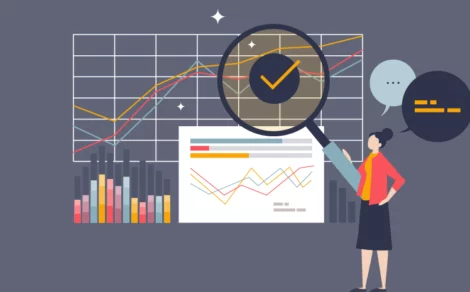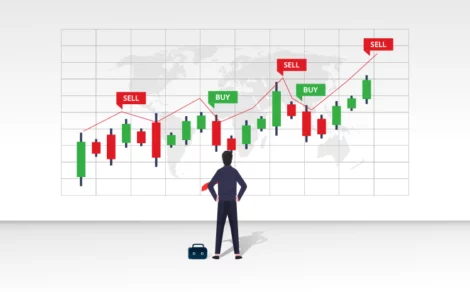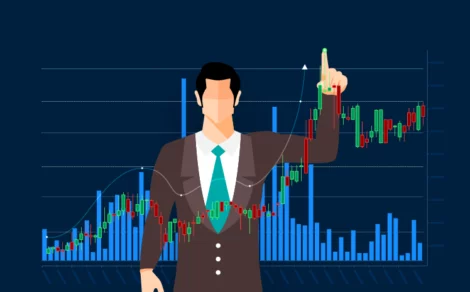You can start by reading educational materials, attending webinars, and practising on a demo account. Many brokers offer resources to help beginners understand the basics of forex trading.
Toruscope » Forex & Currency Trading » A Beginner’s Guide to Starting Forex Trading
Forex trading is increasingly becoming popular with traders looking to diversify their investment portfolios. In India, the forex market is overseen by regulatory bodies like the Securities and Exchange Board of India (SEBI) and the Reserve Bank of India (RBI). Trading is permitted only through authorised brokers and on recognised exchanges such as the NSE (National Stock Exchange) and the BSE (Bombay Stock Exchange).
If you are curious about how to trade forex in India, this article covers the key aspects of the topic to help you navigate this dynamic market with confidence.
Understanding Forex Trading Fundamentals
Forex trading is defined as the process of buying and selling currencies with the target of earning profits from movements in exchange rates. Here are the key aspects of forex trading in India:
- Buying and selling currencies happen in pairs, with traders speculating on one currency’s value against another.
- Banks and financial institutions drive the market with high-volume trades, setting the foundation for retail participation.
- Retail traders access forex through regulated brokers who provide platforms for trading various currency pairs.
- Traders profit by predicting price movements between currencies, such as buying EUR/USD when expecting Euro strength.
Major Forex Trading Sessions (24-Hour Cycle)
| Trading Session | Opens (GMT) | Closes (GMT) | Opens (IST) | Closes (IST) |
| Sydney | 22:00 Sun | 07:00 Mon | 03:30 Mon | 12:30 Mon |
| Tokyo | 00:00 Mon | 09:00 Mon | 05:30 Mon | 14:30 Mon |
| London | 08:00 Mon | 17:00 Mon | 13:30 Mon | 22:30 Mon |
| New York | 13:00 Mon | 22:00 Mon | 18:30 Mon | 03:30 Tue |
Note: The cycle repeats Tuesday through Friday. The forex market closes when the New York session ends on Friday and reopens when Sydney begins on Sunday.
Indian Currency Derivatives Trading Hours
| Exchange | Trading Days | Opens (IST) | Closes (IST) |
| NSE | Monday-Friday | 09:00 | 17:00 |
| BSE | Monday-Friday | 09:00 | 17:00 |
How To Start Forex Trading: A Step-by-Step Approach
Here are the steps you must follow to start trading in forex:
1. Educate Yourself
Before risking your hard-earned money, invest time in understanding how the forex market works. Learn about currency pairs, leverage, pips, and other forex terminology using resources like online courses and books.
2. Choose a Reliable Broker
Identifying a reliable broker is vital for your trading journey. In India, ensure that your broker is regulated by SEBI and RBI. A good broker will offer:
- User-friendly trading platforms
- Reasonable spreads and commissions
- Proper educational resources
- Reliable customer support
- Secure banking options
3. Open a Trading Account
Once you have chosen a broker, you need to open a trading account. You don’t need a demat account for forex trading in India. The process typically involves:
- Completing KYC (Know Your Customer) verification
- Funding your account with an initial deposit
- Setting up your trading platform
Most brokers offer both web-based and mobile trading applications, allowing you to monitor and execute trades from anywhere.
4. Practice With a Demo Account
To hone your trading skills, start practising using a demo account provided by your broker. This will help you familiarise yourself with the trading platform, test different strategies, and understand market dynamics without financial risk.
5. Develop a Trading Plan
A well-rounded trading plan is crucial for achieving desired goals. Your plan should include:
- Financial Goals: Set clear money targets you want to achieve through trading. You need specific numbers to aim for and deadlines to meet them, making it easier to track your progress.
- Risk Management Rules: Decide how much money you are willing to lose on each trade. These rules protect your trading account from big losses and help you stay in the game longer.
- Entry and Exit Strategies: Plan exactly when you will buy and sell before you make any trade. This helps you avoid making emotional decisions when prices are moving and keeps your trading consistent.
- Time Commitment: Be honest about how many hours you can spend watching markets and researching. Your available time needs to match your trading style and fit around your personal life.
- Total Position Size Limits: Set a maximum amount of your money that can be in trades at once. This prevents you from risking too much during market swings and keeps your investments balanced.
Remember, trading without a plan is like navigating without a map. You might reach your destination, but the journey will be unnecessarily challenging.
Popular Forex Trading Strategies
Here are five widely used forex trading strategies that have proven effective for traders worldwide:
- Trend Trading: Follow established market momentum by identifying directional price movements using trendlines and moving averages. Enter trades in the direction of the trend for potentially larger profits. For example, you decide to buy EUR/USD after spotting an uptrend confirmed by the price breaking above a 50-day moving average.
- Range Trading: Capitalise on sideways market conditions by buying near support levels and selling near resistance within established price boundaries. This is ideal for low-volatility periods with predictable movements.
- Scalping: Execute numerous short-term trades lasting minutes to capture small price movements. This strategy requires quick decision-making, tight stop-losses, and focuses on high-liquidity market hours.
- Day Trading: Complete all positions before market close to avoid overnight exposure risks. This strategy typically uses 1-2 hour timeframes and suits traders who prefer clean daily slates.
- Swing Trading: Hold positions for several days to capture short-term price patterns and market swings. This helps balance time commitment with potential returns, using half-hour to hourly chart analysis. For instance, you notice INR/USD starting an upward swing on the daily chart and hold a sell position for 3-4 days to capture the move as the Rupee weakens against the Dollar.
Important Forex Trading Tools
To be successful in forex trading, you need to leverage the combined strength of technical analysis and fundamental analysis. Here are the important details of these tools for you:
Technical Analysis
Technical analysts study historical price data to identify patterns and predict future price movements. Common technical tools include:
- Moving Averages: Lines that show you the average price over a specific time period. They help you spot trends and potential buy/sell points when prices cross these lines.
- Support and Resistance Levels: Price zones where markets tend to stop and reverse. These are like invisible floors and ceilings that can help you decide where to enter or exit trades.
- Chart Patterns: Specific shapes that form on price charts, like triangles, head and shoulders, or double tops. You can use these patterns to predict which way prices might move next.
- Technical Indicators: Mathematical calculations based on price or volume that appear as lines on your charts. They help you measure momentum, trend strength, and potential market turning points.
Fundamental Analysis
Fundamental analysts track economic indicators such as:
- Interest Rate Decisions: Central bank announcements that affect currency values. Higher rates typically strengthen a currency; lower rates usually weaken it.
- GDP Growth Rates: Numbers showing how much a country’s economy is growing or shrinking. Stronger growth often leads to stronger currency values.
- Inflation Data: Measurements of how fast prices are rising in an economy. This affects purchasing power and influences central bank decisions.
- Employment Figures: Reports showing job creation and unemployment rates. Strong job markets typically support currency strength.
- Geopolitical Events: Major world events like elections, conflicts, or trade agreements. These can cause sudden and significant currency price movements.
Combining both approaches often yields better results than relying solely on one forex trading strategy.
How To Manage Forex Trading Risks?
No matter how effective your trading strategies are, risk management remains crucial. Here are some risk management principles:
- Limit yourself to a trade size not exceeding 1-2% of your capital.
- Use stop-loss orders to limit potential losses.
- Don’t chase losses with larger positions.
- Do not get emotional while making trading decisions.
- Regularly review and adjust your trading style.
Practical Considerations for Indian Forex Traders
If you are trading from India, be aware of certain regulatory aspects:
- Indian residents can legally trade currency derivatives on exchanges like NSE, BSE, and MSE.
- Trading is generally limited to certain currency pairs involving the Indian Rupee, such as USD/INR, EUR/INR, GBP/INR, and JPY/INR.
- Cross-currency pairs are also available but with specific restrictions, including EUR/USD, GBP/USD, and USD/JPY with predefined lot sizes.
- Transactions must be conducted through authorised brokers and platforms.
Forex trading offers numerous opportunities, but it’s important to begin your journey with realistic expectations and a commitment to continuous learning.
Conclusion
Starting your forex trading journey requires patience, discipline, and a willingness to learn. By educating yourself, choosing the right broker, practising with a demo account, and creating a well-rounded trading strategy, you can navigate the forex market with greater confidence and potential for success.
Ready to explore investment opportunities in India? Consider opening a trading account with Torus Digital to access various financial markets through a trusted platform.
Frequently Asked Questions
The 5-3-1 rule suggests focusing on five currency pairs, employing three trading strategies, and trading at one specific time of day. This approach aims to help traders maintain focus and consistency.
Start by learning everything about the basics of forex trading, choose a SEBI-registered broker, open a trading account, practise with a demo account, and develop a solid trading plan before investing real money.
Yes, you can engage in forex trading legally through authorised brokers and on recognised exchanges. Trading in currency pairs other than those involving the INR or through unauthorised platforms is either restricted or prohibited under the Foreign Exchange Management Act (FEMA).
Related Reads
How to Calculate F&O Turnover: A Practical Guide for Traders
Trading in futures and options (F&O) isn't just about market strategies and profit margins;...
By: torus
- 8 mins
- 14.May.2025
- 0(0)
- 290
Understanding Forex Trading: A Complete Guide for Indian Investors
Forex trading has emerged as an appealing option for many Indian investors seeking new...
By: torus
- 13 mins
- 13.May.2025
- 0(0)
- 255
Is Forex Trading Legal in India?
The global currency market appeals to millions of traders worldwide with its accessibility and...
By: torus
- 8 mins
- 05.May.2025
- 0(0)
- 558
What is Forex Trading & How Profitable is It?
The world of forex trading has captured the imagination of countless Indian investors looking...
By: torus
- 9 mins
- 05.May.2025
- 0(0)
- 471
Disclaimer: The content provided in this blog is for informational purposes only and does not constitute financial advice or recommendations. The content may be subject to change and revision. Readers are encouraged to conduct their own research and consult with a qualified financial advisor before making any investment decisions. Torus Digital and its affiliates takes no guarantees whatsoever as to its completeness, correctness or accuracy since these details may be acquired from third party and we will not be responsible for any direct or indirect losses or liabilities incurred from actions taken based on the information provided herein. For more details, please visit www.torusdigital.com.
Tenneco Clean Air IPO Listing: Strong Market Debut with 27% Premium
Tenneco Clean Air India Ltd made a confident entrance into the public markets on...
By: torus
- 5 mins
- 19.Nov.2025
-
3.7(6)
-
288
Stock to Buy Today: November 19, 2025
The Indian stock market witnessed a mild decline on November 18, 2025, ending a...
By: torus
- 4 mins
- 19.Nov.2025
-
4.3(3)
-
288
Mirae Asset Infrastructure Fund NFO: A Sector-Focused Bet on India’s Growth
Mirae Asset Mutual Fund has launched a new equity scheme — Mirae Asset Infrastructure...
By: torus
- 4 mins
- 18.Nov.2025
-
4.3(6)
-
288
Emmvee Photovoltaic IPO: Shares Make Muted Market Debut, List Flat At ₹217
Emmvee Photovoltaic Power made a muted debut on 18 November 2025, listing flat at...
By: torus
- 3 mins
- 18.Nov.2025
-
3.7(6)
-
288






